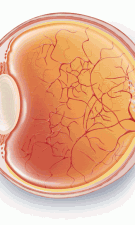CAN YOU FIGHT FAILING VISION without surgery?
HAVE YOU NOTICED YOUR eyesight deteriorating? Maybe you suffer with blurry vision or have difficulty adjusting to very bright conditions?
If so, you could be suffering from macular degeneration which affects people over the age of 60 but can also develop in those in their forties and fifties.
Age-related macular degeneration (also known as AMD) is a progressive condition which affects a small part of the retina at the back of your eye called the macula. The resulting problems of AMD include distorted or blurry central vision, sensitivity to light and may affect one or both eyes. The impact it has on your eyesight means looking directly at something – such as a newspaper or the television – becomes extremely difficult to see clearly. Over a period of time, your slightly blurry or distorted vision will develop a ‘blank spot’ in your central vision.
How Age-related Macula Degeneration affects your vision
There are two types of Age-related Macula Degeneration. There is ‘wet’ (neovascular) or ‘dry’ (non-neovascular). About 10% of those who suffer from macular degeneration have wet AMD. This type occurs when new vessels form to improve the blood supply to oxygen-deprived tissue in the retina. However, the new vessels break easily, causing bleeding and damage to the cells of the macula. The most common is ‘dry’ macula degeneration, gradual deterioration of cells over years. This form of AMD is marked by ‘drusen’ which are small deposits of damaged cell waste within the retina and prevent the flow of healthy nutrients to the retina and macula – vital for seeing any detail. AMD does not affect peripheral vision or lead to total blindness.
There are 3 stages to dry AMD and these can occur in one or both eyes:
1. Early AMD
Those with early AMD have either several small damaged patches in their eye known as ‘drusen’ or a few medium-sized patches. At this stage, there are no symptoms and no vision loss.
2. Intermediate AMD
By this time, many medium-sized drusen has developed. Some people see a blurred spot in the centre of their vision. More light may be needed for reading and other tasks.
3. Advanced Dry AMD
In addition to drusen, people with advanced dry AMD have a breakdown of light-sensitive cells and supporting tissue around the centre of the retina. This breakdown contributes further to blurred spot in the centre of your vision. Over time, the blurred spot may get bigger and darker, taking more of your central vision. It may be difficult to read or recognise faces.




